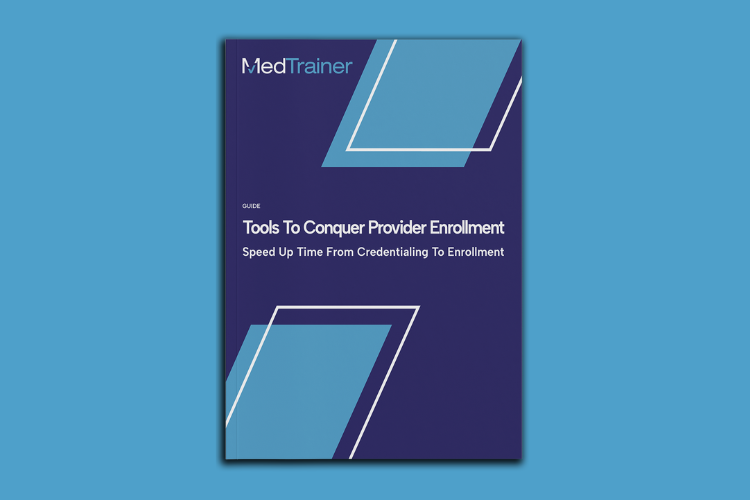Urgent care centers occupy a unique position in the healthcare landscape, offering a distinct blend of accessibility, efficiency, and scope of care that differentiates them from other healthcare facilities. They’re also often quicker to adapt to changes in healthcare demand, technology, and patient preferences, so naturally, urgent care credentialing would be at the forefront of new practices and technology.
Let’s look at the industry’s unique credentialing process, challenges, and how urgent care centers are adopting technology to prepare for the future.
The Credentialing Process For Urgent Care Providers
The credentialing process for urgent care providers is very similar, if not the same, as in other care settings. The process spans various stages, including primary source verification, work history and reference checks, background checks, and payer enrollment, potentially extending up to 150 days. At a minimum, these are standard documentation requirements:
- National Provider Identification (NPI) number
- Current Curriculum Vitae (CV)
- Copies of professional state licenses and DEA licenses
- Board certification information
- Professional liability insurance information
- Peer and professional references
- Continuing Medical Education (CME) documents
Providers, or the organization, must also make a decision on which insurance companies they will accept. This initial choice can significantly impact the urgent care center’s patient base and operational dynamics. Following this, providers embark on the enrollment phase, a prerequisite for accepting insurance and treating patients.
Many payers require providers to maintain a CAQH ProView profile. CAQH credentialing is designed to alleviate the work for providers because many major payers can access that information without the provider completing a separate application.

Get the tools you need to eliminate delays in your provider enrollment process.
Common Challenges In Urgent Care Credentialing
Urgent care center staff move quickly, seeing a high volume of patients. Any challenges encountered in the credentialing process can have a significant financial impact on the center when a physician cannot see patients or claims are being denied. According to Merritt Hawkins, one physician’s revenue for an organization is $9,000 per day, so even a few days’ delay can have a considerable impact.
Here are some of the most common challenges in urgent care credentialing:
- Complexity and Variability of Requirements: Urgent care centers provide a broad range of services and accept many types of insurance. Credentialing requirements can vary significantly between provider types, payers, states, and healthcare facilities, adding complexity to the process. Staying updated with the latest requirements and ensuring compliance can be challenging.
- Lengthy Processing Times: The average credentialing process can take anywhere from 60 to 180 days. Common mistakes include timing, planning, data entry, application processing errors, compliance issues, and lack of digital support. These challenges underscore the importance of meticulous planning and execution.
- Keeping Up with Renewals and Expirations: In the fast-paced urgent care environment, missing a re-credentialing deadline or license expiration date is easy. Failure to renew on time can result in a provider being unable to practice, affecting staffing levels and patient care.
Addressing these challenges head-on with strategic planning and technology can streamline the urgent care credentialing process, ultimately benefiting providers and patients.
Optimizing Credentialing Through Technology
Adding technology to your credentialing process offers speed and efficiency that cannot be replicated using a manual process. That’s why Infinity Business Insights predicts the global provider credentialing software market, valued at $1.3 billion in 2021, will reach $5.6 billion by 2030. Innovations that offer enhanced accessibility, scalability, and data security are in high demand as urgent care centers look for ways to streamline the credentialing workflow.
Automation
Automating tedious and time-consuming tasks such as reminding providers to submit documents and checking exclusions databases helps free up time for credentialers and reduces frustration. Leading credentialing software offers a secure online portal for providers to upload the documents required by your urgent care center and automated email reminders that continue until completed. You can also automate reminders to stay on top of important deadlines, like re-credentialing and expiration. Automated exclusions monitoring and license verification eliminate the website hopping and waiting — again, freeing up valuable time for credentialers to spend on the tasks that require a human touch.
Workflows
With so many moving parts in the credentialing process, it is easy to miss a step or let too much time pass between steps. Credentialing software offers customizable workflows to keep your urgent care center’s process on track so you can submit a complete credentialing packet the first time. Workflows may include a built-in checklist with assignable tasks and reminders and dashboards showing outstanding items and due dates.
Transparency
Without credentialing software, it is very difficult for leadership to have visibility into the process — or for the process to continue uninterrupted if a credentialer leaves the organization. With all documents and information in a central provider profile and all actions tracked in one cloud-based platform, anyone with access can see precisely what has been completed and what is yet to be done for each provider. Dashboards can provide this in a high-level view with the enrollment metrics needed to make business decisions.
Real-Time Reporting
The in-depth reporting included with leading credentialing software provides the insight and visibility you need to keep processes on track and share data with leadership through scheduled reports emailed regularly (daily, weekly, monthly). Every urgent care center operates differently and prioritizes different metrics. Make sure to choose software with customizable enhanced credentialing reporting so you can select the data and filters you need, then save the reports you use most often.
By leveraging these technological advancements, urgent care centers can enhance efficiency, reduce errors, and maintain compliance, ultimately improving patient care and operational effectiveness.
The Future Of Credentialing In Urgent Care Centers
As the industry moves toward a more efficient future, the role of technology, particularly credentialing software, becomes undeniably central in optimizing operational effectiveness and enhancing patient care quality. The advent of AI to enable efficiency in credentialing processes not only promises enhanced security and accessibility but also paves the way for a more seamless healthcare delivery system. For those looking to advance their urgent care credentialing process with cutting-edge technology, explore how MedTrainer Credentialing Software can significantly reduce turnaround times and improve accuracy, marking a pivotal step toward operational excellence and unparalleled patient care.
